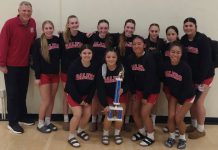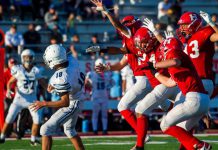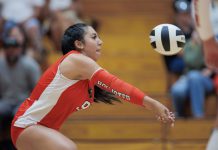
Youth sports in the area have allowed athletes to experience,
develop and progress at a younger age, as well as prepare for
future endeavors
Former San Benito starting pitcher Marisa Ibarra
— soft-spoken, mild-mannered and standing all of just
5-feet-2-inches tall — certainly said a lot with her explosive
right arm over four seasons for the Balers softball team.
She struck out 816 batters in her high school career, racked up
43 wins in the Tri-County Athletic League, 108 overall, and
recorded 10 no-hitters, including four perfect games.
Youth sports in the area have allowed athletes to experience, develop and progress at a younger age, as well as prepare for future endeavors
Former San Benito starting pitcher Marisa Ibarra — soft-spoken, mild-mannered and standing all of just 5-feet-2-inches tall — certainly said a lot with her explosive right arm over four seasons for the Balers softball team.
She struck out 816 batters in her high school career, racked up 43 wins in the Tri-County Athletic League, 108 overall, and recorded 10 no-hitters, including four perfect games.
But for all the accolades her powerful wind-up bestowed, Ibarra, who will be entering her sophomore campaign at San Francisco State in the fall, might not have reached those heights without her initial start through the Hollister Heat, as the seeds of her high-school dominance were planted well before she started at that level.
“I would definitely say playing softball growing up helped,” Ibarra said.
It was through the Heat that she learned techniques she still employs today, that she discovered pitching while relinquishing her initial third-base duties, and where she met Lizzy Gatto, Elena Fata, Bri Romero and J.C. Clayton, who made up the infield for San Benito during her junior season.
Ibarra played with roughly the same teammates in high school from when she first started playing competitively as an 11-year-old with the Heat. She was comfortable and confident with the squad behind her, and although her right arm did most of the talking, Ibarra knew how important familiarity can be while trying to stay relaxed on the mound.
“I think it’s like any other team,” said Leo Ibarra, Marisa’s father and president of the Hollister Heat. “The better you know your teammates, you know their strengths and weaknesses, it makes the pitcher that much more confident.
“Team chemistry is a big part of any team sport. If you go through high school playing with the same girls you’ve been playing with since you were 12 years old, it’s that much easier.”
The benefits and success of the Heat, youth sports and travel clubs in the San Benito County area, in general, have certainly opened up more avenues for young athletes to compete, develop and progress at an earlier age. Although playing and competing with the same teammates for several years prior to high school remains a somewhat rare case, especially in softball where several different travel ball clubs are in the nearby area, the youth scene is widespread compared with years past.
Whether implanting the skills that will jump-start a lengthy career, or just instilling a comfortable bond with teammates early on, youth sports have made younger athletes better prepared for future endeavors.
Supportive coaches and parents have morphed programs such as Hollister Little League, Hollister Youth Football & Cheer, the San Benito Cardinals, San Benito Babe Ruth, Hollister NJB and the Hollister Tremors Youth Soccer Club, among others, into top-notch organizations, and the high school, for one, sees the benefits.
This past spring, without many of the names that made headlines in years past, Ibarra included, the San Benito softball team nevertheless earned its fifth straight Central Coast Section Division I title with a starting lineup that included three freshmen, a sophomore and five juniors.
Without the Heat and other travel ball programs in the area, it’d be difficult to imagine an unprecedented fifth Division I title for such a youthful, seemingly inexperienced team.
“We used to work on hitting and throwing and base running. Now we’re working on strategy and philosophy,” said Scott Smith, manager of the SBHS softball team, who admitted that having talented players makes his job easier, but also adds to the pressure. “It certainly helps them come to the high school and play at a high level. By the time they’re freshmen, they’re extremely committed.”
Smith can recall his first season at San Benito in 2003, when he said he had one player on the team who played travel softball during the offseason.
“This year, I think it was everybody but one or two,” he added. “That couldn’t happen without the parents participating.
“Parents aren’t afraid to get involved, and I think the biggest push I’ve seen is in girls sports.”
That’s perhaps because of the equality of girls scholarships at the college level, with the passing of Title IX opening up more opportunities for female athletes. Youth sports are often the icebreaker for what the future might bring.
“The mindset of the youth has changed,” Smith said. “They’re not thinking of the present. They’re thinking of the future.”
Youth coaches like Ibarra take this into account. The Heat organization tries to educate its coaches, even with coaches clinics through SF State, with the best knowledge possible in order further develop the skills and fundamentals of the roughly 250 girls that adorn a Heat uniform every year.
Although the Heat travel teams compete at a ‘B’ level, it’s the starting point for roughly every softball player in Hollister. In fact, mostly every player on the current SBHS softball team played for the Heat at one level or another.
“We are a rec team, a rec organization, just developing the taste of what travel ball is all about,” Ibarra said.
Sara Yamasaki made her way up through the Hollister Tremors Youth Soccer Club at a younger age before joining the Orchard Valley Sting, which is based out of Morgan Hill and includes five other members of the San Benito girls soccer team.
Yamasaki, an incoming senior at SBHS, previously played club volleyball and club soccer while in the eighth grade, but cut back before entering high school after her parents told her to choose just one sport.
Although she still plays volleyball for the high school, her choice in soccer may pave the way to the next level — she’s currently being recruited by Cal State East Bay.
“I decided to go to a club when I became more interested in the sport,” Yamasaki said. “I just wanted to keep on playing and my parents signed me up for the next club season.
“I think it’s great because you get to travel around and I like bonding with the team.”
Yamasaki admits that playing for a club is a “huge” commitment, but it’s become almost second nature — she’s been playing for the Sting since she was 12.
“And I think it helps when you play year-round,” she said. “I think it helps a lot. You’re playing in the offseason and when you come into high school, you’re ready.”
Daniel Barone can’t remember playing for any travel ball team when he was growing up. The Hollister resident made his way to the major leagues and the Florida Marlins organization in 2007, but never played for a club team while moving up the ranks.
“But I would have loved travel ball growing up,” said Barone, who now runs Barone’s Baseball in Hollister and provides hitting and pitching lessons to area youths. “It’s 100 percent beneficial. The more repetitions you get, the better you become.”
Barone, along with coach Kalev Betancourt, recently started Barone’s 21s (7 innings, 21 outs), a 13-and-under travel team that will play in just its third tournament on Aug. 21 in Sacramento. The team finished runner-up last weekend in a tournament at Twin Creeks.
Barone says the overall talent level for younger athletes has increased since he was younger, with better quality of coaching, better knowledge of the game itself and more options offered across the board.
“These boys are studs,” Barone said. “They’re way better than I was at their age.
“The coaching has stepped up. The talent has stepped up. The kids look good.”
The Hollister Youth Football & Cheer, otherwise known as Pop Warner’s Hollister Vikings, make it a point to provide the roughly 230 kids who dress in purple and gold with the highest quality in coaching.
President Larry Murphy makes all of his head coaches and assistant coaches go through USA Football’s online training tutorials, has his coaches attend Gavilan head football coach John Lango’s free clinic, and urges his staff to seek out other clinics in the area as well.
Murphy himself, who also coaches the pee wee division, attends three or four clinics every year.
“As the year changes, the kids change,” said Murphy, whose son Michael recently graduated from SBHS and will play football for North Dakota State in the fall. “You’ve got to keep their attention or they’ll walk. They’re not having fun.”
Murphy realizes the catch-22 that comes with youth sports — helping players learn the sport in order to succeed, but not to stress winning so much that it becomes a deterrent. Murphy and his coaches still meet once a week to review game film and prepare for the next opponent, as well as meet three times a week for practice, feeling anything less would be a disservice to the players.
“You want to give the kids the opportunity to be successful and if you’re not, you’re not giving the kids a chance,” Murphy said. “The kids are just passing through us. We’re gonna teach them what we can teach them and they’re gonna move on.”
Although it’d be too difficult to replicate the schemes and packages and play-calls of the high school team at the Pop Warner level, Murphy and his coaching staff realize the importance of instilling the basics into their players, knowing that in just a few short years the game will become much harder and much faster.
“We’re just scratching the surface,” he said. “I’m just trying to give them an idea and help them out.
“But it’s very important for youth coaches to work. If you don’t do a good job, you’ll lose that kid forever to the sport.”









